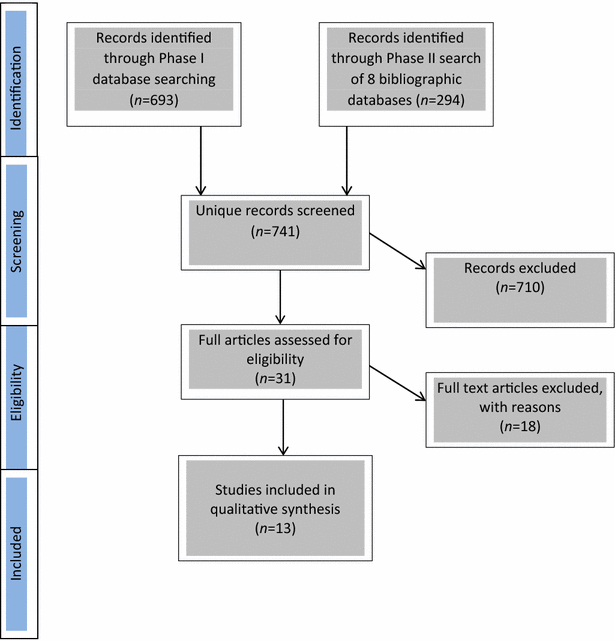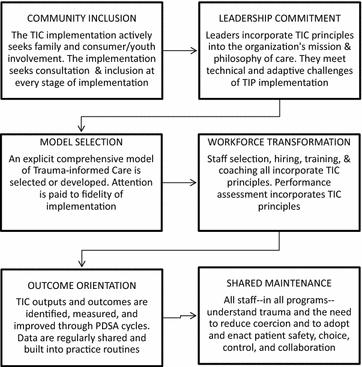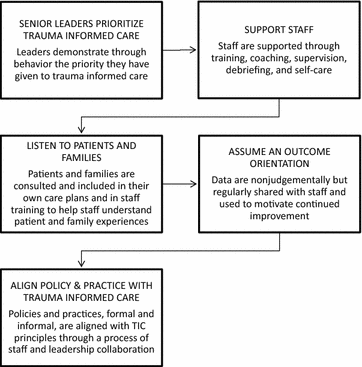What are effective strategies for implementing trauma-informed care in youth inpatient psychiatric and residential treatment settings? A realist systematic review
- PMID: 28503194
- PMCID: PMC5425975
- DOI: 10.1186/s13033-017-0137-3
What are effective strategies for implementing trauma-informed care in youth inpatient psychiatric and residential treatment settings? A realist systematic review
Abstract
Background: Many young people who receive psychiatric care in inpatient or residential settings in North America have experienced various forms of emotional trauma. Moreover, these settings can exacerbate trauma sequelae. Common practices, such as seclusion and restraint, put young people at risk of retraumatization, development of comorbid psychopathology, injury, and even death. In response, psychiatric and residential facilities have embraced trauma-informed care (TIC), an organizational change strategy which aligns service delivery with treatment principles and discrete interventions designed to reduce rates of retraumatization through responsive and non-coercive staff-client interactions. After more than two decades, a number of TIC frameworks and approaches have shown favorable results. Largely unexamined, however, are the features that lead to successful implementation of TIC, especially in child and adolescent inpatient psychiatric and residential settings.
Methods: Using methods proposed by Pawson et al. (J Health Serv Res Policy 10:21-34, 2005), we conducted a modified five-stage realist systematic review of peer-reviewed TIC literature. We rigorously searched ten electronic databases for peer reviewed publications appearing between 2000 and 2015 linking terms "trauma-informed" and "child*" or "youth," plus "inpatient" or "residential" plus "psych*" or "mental." After screening 693 unique abstracts, we selected 13 articles which described TIC interventions in youth psychiatric or residential settings. We designed a theoretically-based evaluative framework using the active implementation cycles of the National Implementation Research Network (NIRN) to discern which foci were associated with effective TIC implementation. Excluded were statewide mental health initiatives and TIC implementations in outpatient mental health, child welfare, and education settings. Interventions examined included: Attachment, Self-Regulation, and Competency Framework; Six Core Strategies; Collaborative Problem Solving; Sanctuary Model; Risking Connection; and the Fairy Tale Model.
Results: Five factors were instrumental in implementing trauma informed care across a spectrum of initiatives: senior leadership commitment, sufficient staff support, amplifying the voices of patients and families, aligning policy and programming with trauma informed principles, and using data to help motivate change.
Conclusions: Reduction or elimination of coercive measures may be achieved by explicitly targeting specific coercive measures or by implementing broader therapeutic models. Additional research is needed to evaluate the efficacy of both approaches.
Keywords: Implementation science; Inpatient psychiatric care; Residential care; Trauma informed practice; Trauma-informed care; Youth mental health.
Figures
References
-
- Herman J. Trauma and recovery: the aftermath of violence from domestic abuse to political terror. New York: Jossey-Bass; 1992.
-
- Shonkoff J, Phillips D. From neurons to neighborhoods. Washington: National Academy Press; 2000. - PubMed
Publication types
LinkOut - more resources
Full Text Sources
Other Literature Sources




